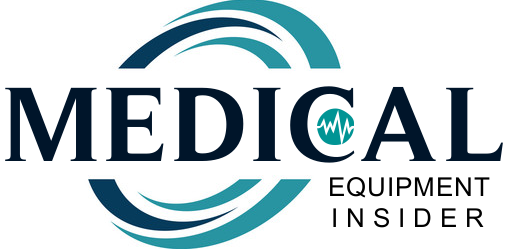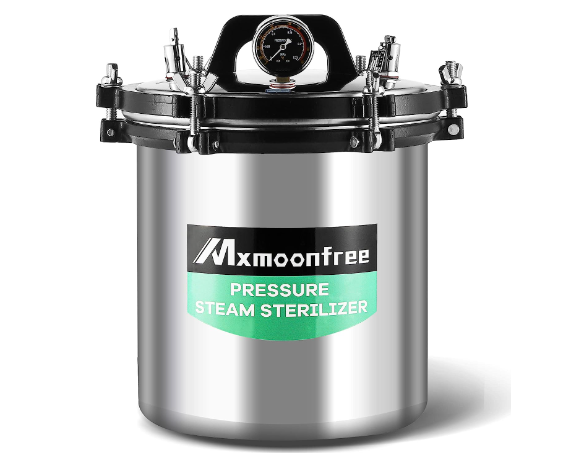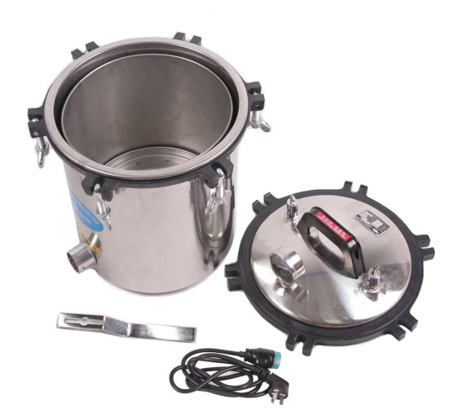The search for the best portable autoclave machine for surgical equipment has become increasingly essential when catering to the need for mobility without compromising on sterilization efficacy.
In the rapidly evolving field of medical technology, the demand for efficient and reliable sterilization methods is paramount, particularly when it comes to surgical equipment.
This introduction explores the cutting-edge advancements and features of a top-tier portable autoclave, highlighting its significance in maintaining the utmost hygiene standards for surgical procedures while offering the convenience of portability for modern healthcare settings.
What Is an Autoclave Machine
An autoclave machine is a piece of equipment used for sterilizing objects and substances through high-pressure steam and heat.
It is commonly used in medical, dental, pharmaceutical, and laboratory settings to ensure that equipment, instruments, and materials are free from microorganisms such as bacteria, viruses, and spores.
Autoclaves are essential tools in maintaining strict hygiene and infection control standards in healthcare and laboratory environments.
They are particularly important in surgical settings, where the cleanliness and sterility of instruments are critical to prevent infections and ensure successful procedures.
How Does an Autoclave Machine Work
The autoclave works by creating a sealed chamber where the items to be sterilized are placed. Steam is then introduced into the chamber at a high temperature and pressure, typically around 121-134 degrees Celsius (250-273 degrees Fahrenheit) and 15-30 psi (pounds per square inch).
The combination of high heat and pressure effectively kills and eliminates any potentially harmful microorganisms, making the items safe for use in various medical and scientific procedures.
What To Consider When Buying Best Portable Autoclave Machine for Surgical Equipment
When buying the best portable autoclave machine for surgical equipment, there are several important factors to consider to ensure you make an informed and suitable choice. Here are some key considerations:
Sterilization Efficiency
Check the autoclave’s sterilization efficacy. Look for machines that meet or exceed industry standards for sterilization, ensuring that they can effectively eliminate bacteria, viruses, and spores from surgical instruments.
Size and Capacity
Consider the size and capacity of the autoclave. Ensure it is large enough to accommodate the surgical equipment you need to sterilize while still being portable and easy to transport.
Portability and Mobility
Look for autoclaves that are specifically designed for portability. Consider the weight, dimensions, and any features that facilitate easy movement, such as built-in handles or wheels.
Power Source
Check the power source requirements of the autoclave. If you need to use it in locations without a reliable power supply, consider models that offer alternative power options like battery or gas.
Sterilization Cycle Options
Ensure the autoclave provides various sterilization cycle options to accommodate different types of surgical equipment and materials. Look for flexibility in cycle settings, including temperature, pressure, and exposure time.
Safety Features
Safety is crucial when working with an autoclave. Look for models with safety features such as automatic pressure release mechanisms, door locking systems, and temperature controls to prevent accidents and ensure operator protection.
User Interface
A user-friendly control panel and interface are essential, especially if multiple users will operate the autoclave. Intuitive controls and clear displays make it easier to set up and monitor sterilization cycles.
Validation and Compliance
Check if the autoclave meets relevant industry standards and regulatory requirements for sterilization. Look for models with validation data available, indicating the efficacy of the sterilization process.
Maintenance and Service
Consider the ease of maintenance and availability of service and support for the autoclave. Regular maintenance is crucial for reliable and long-lasting performance.
Price and Warranty
Compare prices of different models, considering the features and capabilities they offer. Also, check the warranty period and coverage to ensure your investment is protected.
User Reviews and Recommendations
Read user reviews and seek recommendations from professionals in the medical and scientific fields to get insights into the performance and reliability of specific autoclave models.
Brand Reputation
Choose autoclaves from reputable and well-established manufacturers known for producing reliable and high-quality sterilization equipment.
By carefully considering these factors, you can select the best portable autoclave machine for surgical equipment that aligns with your specific needs, ensuring efficient sterilization and safe surgical practices.
Best Portable Autoclave Machine for Surgical Equipment
-
BAOSHISHAN Stainless Steel Portable Steam Autoclave for surgical equipment
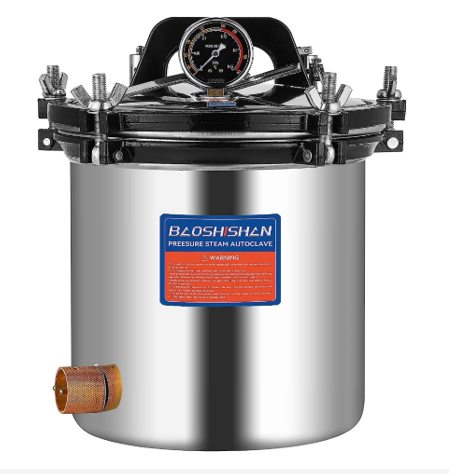
Topping the list is the BAOSHISHAN steam autoclave that is a self-contained pressure canner with technical added accessories to make it easier to use.
In order to avoid pressure explosion, this machine has been designed with two pressure valves on the lid that automatically open when the deflate valve fails to ensure safety under high pressure.
Features
- Dual scale pressure gauge
- 142~0.165MPa (20.59~23.92psi) working pressure
- Dual heating system
- 126~128°C(259~262°F) working temperature
- 19 Quarts(18l) capacity
- 304 Stainless Steel
- Measures 11″L x 11″W x 9.4″H
- Use 2kW
- Weighs 29.3 pounds
- Inner Capacity of 12.6L (13.3QT)
Pros
- Easy to operate
- Can use electricity and coal
- Safe to use under high pressure
- Portable
- Easy to maintain
- Multiple use
- Anti- dry burning
- Comes with a wing wrench
- Easy to read and understand gauge
Cons
- Not ideal for wide surgical equipment
-
APHRODITE Mini High Temperature portable Medical Autoclave
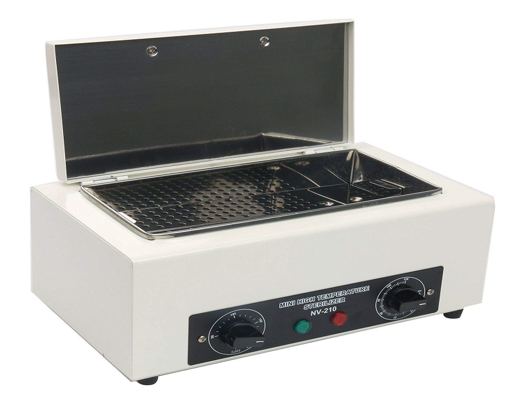
If you are looking for a Medical Autoclave for small surgical equipment used in minor surgical procedure such as skin tag removal and wound dressing then this APHRODITE 300W Mini High Temperature Sterilizer is an ideal choice.
It has a rapid-start heating element for fast operation without pressure, steam or chemicals unlike wet heat methods. This machine utilizes the dry Heat method for sterilization.
Features
- Main machine measures 31 x 18 x 19 cm
- Inside measures 25 x 12 x 5 cm
- Tray size is 24.3 x 11.3 x 2.7cm
- Internal volume of 1.5 l
- Timer of 120 minutes
- Working temperature of 50-200°C
- Voltage:100V-120V/60Hz or 220V-240V/50Hz
- Power: 300 Watts
- Weights 4.20 Kgs.
- Stainless steel tray
Pros
- Adjustable timer
- Portable
- Non slip base
- Fast sterilization
- Portable
- Precision power plug
- Adjustable working temperature
- Saves space
- Suitable for home, office and various occasions.
- Convenient operation.
- Beautiful and practical.
Cons
- Small capacity
-
Prestige Classic Medical 2100 Autoclave
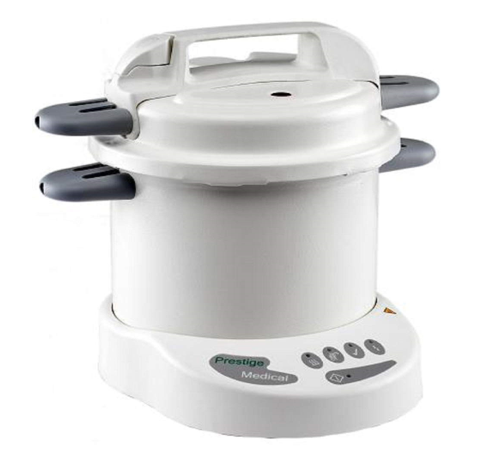
Also making to the list is this Prestige Classic newest Autoclave model with Silver Handles. It is one of the world’s largest-selling and cost-effective automatic autoclaves.
Sold in over 50 countries worldwide, it has gained a desirable reputation for reliability, durability, and quality. This professional grade autoclave is perfect for all small General Medical, Dental and Veterinary applications.
Features
- Operation manual
- Measures H13.2”, W 13.4”, D 8.3″
- Chamber Height of 9.3″
- Weighs 6.6 lbs.
- Calibrated pressure release valve
- Automatic
- Gasket offset device
- Light sequence indicators
- Maximum instrument size of 9″
- Eleven minutes and 126°c sterilizing cycle.
Pros
- Lifetime guarantee on the heating element
- Comes with all standard accessories
- Light weight
- Portable
- Has interlock system
- Compact and robust design
- Fast and easy to operate
- Two-year parts and labor warranty
- Durable
Cons
- Small capacity
-
Tuttnauer 1730 Valueklave portable Autoclave For Small Offices
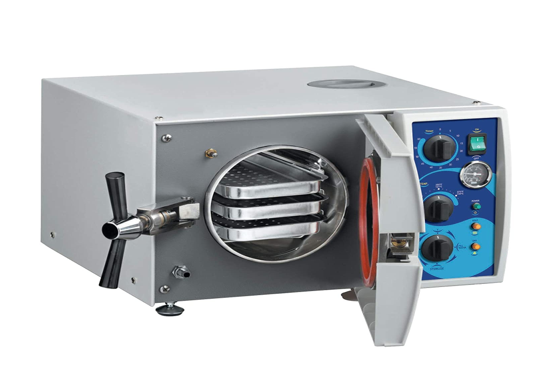
This Tuttnauer 1730 Valueklave will satisfy all of your basic sterilization needs for surgical equipment. The compact size (7 chamber) makes it an ideal primary unit for small offices or a supplement autoclave for larger practices.
The fast cycle time and heated drying delivers a quick turnaround for wrapped or unwrapped instruments. The simple controls and easy closing door make this unit easy to operate.
Its Drain valve is located on the front, allowing for quick and easy draining of water reservoir. Dual safety to protect against overheating.
Features
- Measures 17.9 x 12 x 17.4 inches
- Weighs 50 Pounds
- Includes one sterilizer and three trays
- Sterilizer chamber measures 7” x 13”
- Chamber volume of 2 Gallon
- Tray Size is 11.6” D x 4.7” W x 0.8” H
- Standard Cassettes Capacity is 2 halves
- Voltage/ Frequency is 120V/50-60Hz
- Eleven minutes from a hot start
Pros
- Fast sterilizing cycle time
- Automatic
- Easy to use
- The trays can be used to segregate the surgical tools
- Portable
- Easy to drain water
- Improved version
Cons
- Expensive
-
OLizee Electric Autoclave Sterilizer
OLizee Electric Autoclave Sterilizer comes with exclusive sealing system for a steam-tight seal, easy to read geared steam gauge and automatic overpressure release.
It is a manual autoclave meaning one has to monitor and time the sterilization process to ensure the water does not boil out. It is ideal for medium to large surgical equipment sterilization
Features
- 304 stainless steel
- Voltage of AC110V
- Hand-cast aluminum
- Power of the Electro-Thermal Tube is 2KW
- Capacity of 18L
- Positive action clamping wing nuts
- Inside Dimension is 11.5″x11″
- Working Pressure of 0.14-0.16MPa – 0.165MPa
- Working temperature of 259F/126C.
Pros
- Easy opening and closing.
- Durable
- Easy to clean satin finish
- Sturdy top handle
- Automatic overpressure release.
- Large capacity
Cons
- Has no heating or working timer
-
EustomA High Pressure Steam Autoclave Machine for surgical equipment
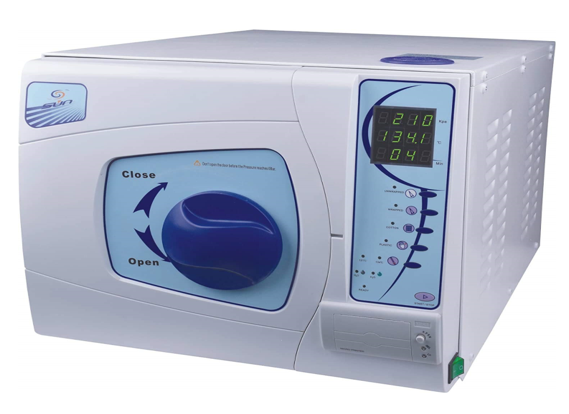
Last but not the list to make it to this review list is EustomA equipment autoclave sterilizer with digital display, vacuum steam and data printing
Features
- 18l capacity
- Working temperature of 122o C -134o C
- Working pressure of 0.12Mpa – 0.22Mpa
- Power (VA)1100 VAC
- 304 Stainless steel
- Measures 12L/16L/18L(445X550X395mm)—23L(445X640X395mm)
- Rated Voltage of 220V±22V, 50Hz±1Hz, 110V±11V, 60Hz±1Hz
- Fuse-Melting pipe: T15A
- 4 Digital display working programs
Pros
- 4L Water Consumption volume per recycling round
- Visual pressure monitoring
- Automatic alarm system
- Three times pre vacuum
- Jet types steam generator
- Has optional inbuilt mini-printer
- USB connector to record the process of working.
Cons
- No dry function
You may also like
6 best portable oral irrigators
best hearing aids in the market for senior citizens
8 best medical scooters for broken foot
How To Use an Autoclave
Proper use of an autoclave is essential to ensure effective sterilization and safety. Here’s a general step-by-step guide on how to use an autoclave:
Preparation
- Check the autoclave’s condition: Make sure the autoclave is in good working order, and all components, such as gaskets and seals, are intact.
- Load the items: Place the items to be sterilized inside the autoclave chamber, ensuring they are arranged in a way that allows steam to reach all surfaces effectively. Avoid overcrowding, as it may hinder proper sterilization.
Sealing
Once the chamber is loaded, the autoclave is sealed tightly to create a closed system. This is crucial to maintaining the high pressure and preventing the escape of steam during the sterilization process.
Setting Parameters
Set the appropriate sterilization parameters: Refer to the manufacturer’s instructions or guidelines to determine the correct temperature, pressure, and sterilization time for the items being sterilized. These parameters may vary depending on the material and size of the objects.
Air Removal (optional)
Some modern autoclaves have a pre-vacuum phase where air is removed from the chamber to create a more effective steam environment.
Removing the air ensures better contact between the steam and the surfaces of the items being sterilized. If your autoclave has this feature, allow the air removal process to complete before proceeding.
Start the Sterilization Cycle
Start the autoclave to initiate the sterilization cycle. The autoclave will begin heating and pressurizing the chamber with steam according to the set parameters.
The temperature and pressure levels are carefully controlled and maintained during the sterilization process. The typical conditions for sterilization are around 121-134 degrees Celsius (250-273 degrees Fahrenheit) and 15-30 psi (pounds per square inch).
Monitor the Cycle
During the sterilization process, monitor the autoclave to ensure it operates correctly. Pay attention to any error messages or alerts that may appear on the autoclave’s control panel if its digital. If the autoclave is manual set and monitor the time.
Drying (optional)
If your autoclave has a drying phase, allow it to complete. Drying helps remove excess moisture from the sterilized items, reducing the risk of contamination.
Cooling and Depressurization
After the sterilization and drying (if applicable) phases are complete, the autoclave will begin to cool down. Do not open the autoclave until the pressure has returned to normal and the chamber is safe to open.
Unloading
Once the autoclave is cool and depressurized, open the door carefully. Remove the sterilized items from the chamber using appropriate protective equipment, such as heat-resistant gloves.
Verification
Check the sterilized items for any visible signs of damage or moisture. Ensure that the sterilization process was successful.
Record Keeping
Maintain a log of the autoclave usage, including the date, time, items sterilized, cycle parameters, and operator’s name. This documentation is crucial for quality control and regulatory compliance.
Always follow the manufacturer’s instructions and any specific guidelines for your particular autoclave model. Additionally, be sure to wear appropriate personal protective equipment (PPE) when operating the autoclave to ensure your safety.
It is important to note and follow the manufactures usage manuals for quality and safety purposes.
FAQs for Best Portable Autoclave Machine for Surgical Equipment
What are the advantages of using a portable autoclave machine over traditional autoclaves?
Portable autoclave machines offer the advantage of mobility and versatility. They are designed to be easily transported, making them suitable for use in field clinics, remote locations, and ambulatory surgical centers. Additionally, they are more convenient for smaller healthcare facilities with limited space.
Can portable autoclave machines run on battery power?
Yes, some portable autoclave machines are designed to operate on battery power, making them suitable for use in areas with limited or unreliable electricity supply. Battery-powered autoclaves provide flexibility and ensure continued sterilization capabilities even in challenging environments.
How often does a portable autoclave machine require maintenance and servicing?
The frequency of maintenance and servicing depends on the model and the intensity of use. Generally, autoclaves require regular maintenance, including routine inspections, calibration, and replacing parts as needed. Manufacturers often provide guidelines for maintenance intervals.
What safety features should I look for in a portable autoclave machine?
Important safety features include automatic pressure release mechanisms, door locking systems during operation, and temperature controls to prevent overheating. Some models also have safety alarms and indicators to alert users of any issues during the sterilization process.
Can a portable autoclave machine sterilize different types of surgical equipment?
Yes, portable autoclave machines can sterilize various types of surgical instruments and equipment, including metal, glass, and heat-resistant plastic items. However, it’s essential to check the compatibility of specific items with the autoclave’s temperature and pressure settings.
Conclusion
In conclusion, the best portable autoclave machine for surgical equipment offers a transformative solution in the field of sterilization.
Its compact and lightweight design, coupled with powerful high-pressure steam technology, ensures efficient and reliable elimination of harmful microorganisms from surgical instruments and materials.
The portability of these autoclaves allows for increased flexibility, making them ideal for various healthcare settings, including field clinics, ambulatory surgical centers, and remote locations with limited access to electricity.
With user-friendly controls and essential safety features, these autoclaves provide ease of operation while prioritizing the protection of both patients and medical staff.
Investing in a reputable portable autoclave machine with adequate sterilization capacity and compliance with industry standards empowers healthcare professionals to maintain the highest hygiene standards, thereby safeguarding patient well-being and fostering successful surgical outcomes.
